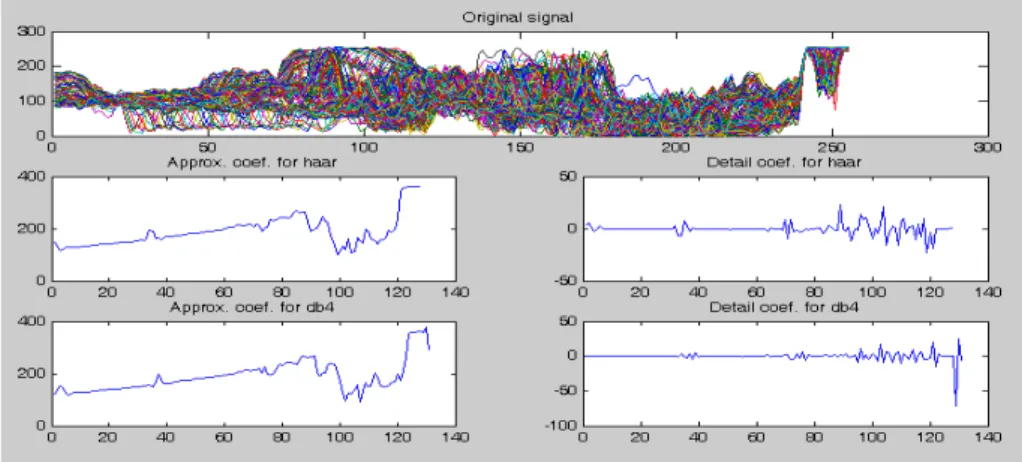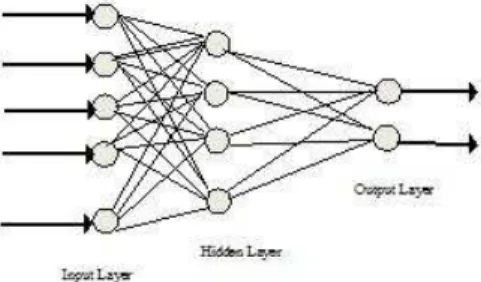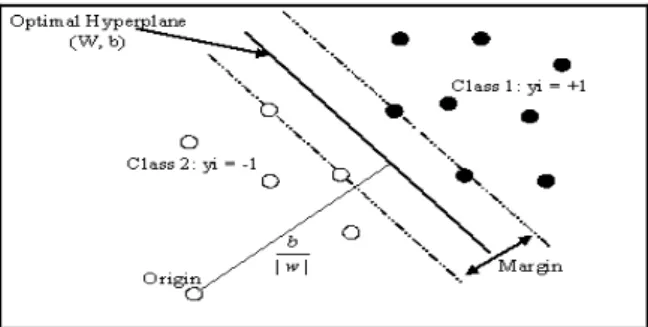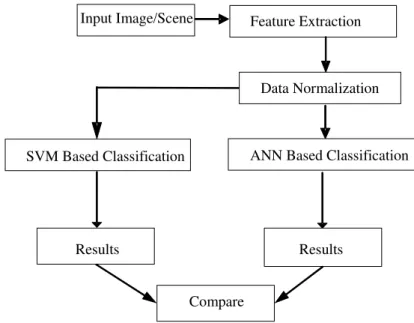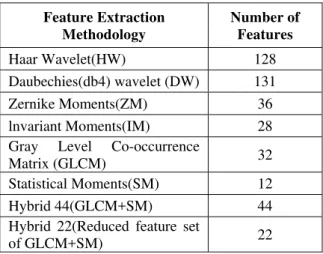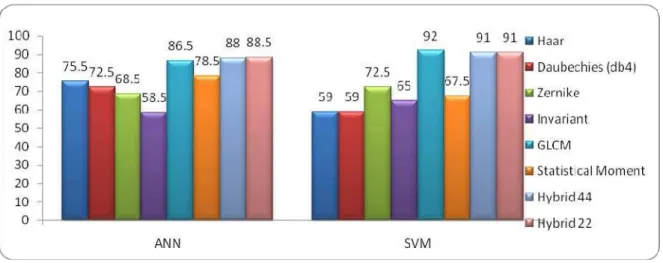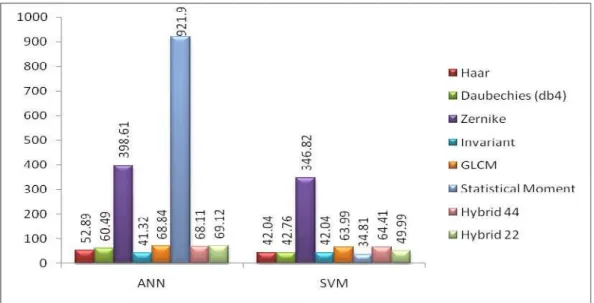Hybrid Feature Based War Scene
Classification using ANN and SVM:
A Comparative Study
Daniel Madan Raja S
Assistant Professor (Sr. Grade), Department of Information Technology Bannari Amman Institute of Technology, Sathyamangalam, Tamilnadu, India
Shanmugam A Principal
Bannari Amman Institute of Technology, Sathyamangalam, Tamilnadu, India
Abstract:
In this paper we are proposing a hybrid feature extraction method for classifying the war scene from the natural scene. For this purpose two set of image categories are taken viz., opencountry & war tank. By using the hybrid method, features are extracted from the images/scenes. The extracted features are trained and tested with (i) Artificial Neural Networks (ANN) using feed forward back propagation algorithm and (ii) Support Vector Machines (SVM) using Radial basis kernel functions with p=5. The results are also compared with the commonly used feature extraction methods such as haar wavelet, daubechies(db4) wavelet, Zernike moments, Invariant moments, co-occurrence features and statistical moments. The comparative results are proving efficiency of the proposed hybrid feature extraction method (i.e., the combination of GLCM & Statistical moments) in war scene classification problems. It can be concluded that the proposed work significantly and directly contributes to scene classification and its new applications. The complete work is experimented in Matlab 7.6.0 using real world dataset.
Keywords: Scene Classification, Artificial Neural Networks, Hybrid Features, Support Vector Machine
1. Introduction
Scene classification refers to classifying the images into semantic categories (e.g. street, bedroom, mountain, or coast) [1], [2], [3]. Scene classification underlies many problems in visual perception such as object recognition and environment navigation. Scene and object classification are important research topics in robotics and computer vision. Computer Vision generally focuses on extracting what is where by merely looking at it. Many research problems have been studied and reported by the research community in the recent years. Classification is one of the several primary categories of machine learning problems [4]. For the indoor - outdoor scene retrieval problem, the authors addressed how high-level scene properties can be inferred from classification of low-level image features [5]. Authors propose an automated method based on the boosting algorithm to estimate image orientations [6]. In [7], Bosch et al. present a scene description and segmentation system capable of recognizing natural objects (e.g., sky, trees, grass) under different outdoor conditions. In paper [8], the authors propose a new technique for the classification of indoor and outdoor images based on edge analysis. Analysis of texture [9] requires the identification of proper attributes or features that differentiate the textures of the image. In our previous work [10][11][12], haar wavelet, daubechies wavelet, Zernike moments, invariant moments and gray level co-occurrence matrices features are used to classify the war scene from natural scene using artificial neural networks and Support Vector Machines.
2. Feature Extraction Methodologies
2.1. Haar and Daubechies (db4) wavelet
Haar and Daubechies [13] wavelets are a widely used technique for feature extraction, which are single-level one-dimensional wavelet decomposition and gives both an approximation and detailed coefficients. Approximation coefficients which are of size 128x1 for Haar wavelet and 131x1 for Daubechies wavelet are considered as the feature set for our problem domain. Pictorial representation of approximation coefficients and detailed coefficients of the above mentioned wavelets are shown in the Fig. 1. Hence, features F1 to F128 and F1 to F131 are considered as feature sets for Haar and Daubechies wavelets respectively.
Figure 1 Original, Approximation and Detailed Coefficients of Haar and Daubechies Wavelets
2.2.Zernike Moments
Zernike polynomials were first proposed in 1934 by Zernike [14]. Their moment formulation appears to be one of the most popular, outperforming the alternatives (in terms of noise resilience, information redundancy and reconstruction capability). The use of the Zernike moments have been frequently utilized for a number of image processing and computer vision task [15] [16]. The kernel of Zernike moments is a set of orthogonal Zernike polynomials defined over the polar coordinate space inside a unit circle. The image is considered as a single block, feature vector of 36x1 is extracted. Thus features F1 to F36 are considered as a feature set in Zernike Moments.
2.3. Invariant Moments
Moment invariants are important shape descriptors in computer vision. The set of seven invariant moments (
φ
1−
φ
7) was first proposed by Hu [17] for 2D images which was widely used contour-based shape descriptor.In terms of the normalized central moments, the seven moments are given below:] ) ( ) ( 3 )[ )( 3 ( ] ) ( 3 ) )[( )( 3 ( ) )( ( 4 ] ) ( ) )[( ( ] ) ( ) ( 3 )[ )( 3 ( ] ) ( 3 ) )[( )( 3 ( ) ( ) ( ) 3 ( ) 3 ( 4 ) ( 2 03 21 2 12 30 03 21 30 12 2 03 21 2 12 30 12 30 03 21 7 03 21 12 30 11 2 03 21 2 12 30 02 20 6 2 03 21 2 12 30 03 21 03 21 2 03 21 2 12 30 12 30 12 30 5 2 03 21 2 12 30 4 2 03 21 2 12 30 3 2 11 2 02 20 2 02 20 1 η η η η η η η η η η η η η η η η φ η η η η η η η η η η η φ η η η η η η η η η η η η η η η η φ η η η η φ η η η η φ η η η φ η η φ + − + + − + + − + + − = + + + + − + − = + − + + − + + − + + − = + + + = − + − = + − = + =
The images are divided into four equal blocks and extracted seven values from each block. Thus, 4x7=28 features are used to represent an input image. Thus features F1 to F28 are considered as a feature set in invariant moments.
2.4. Gray Level Co-Occurrence Matrix (GLCM)
of different gray levels. The method calculates a GLCM by calculating how often a pixel with a certain intensity i occurs in relation with another pixel j at a certain distance d and orientation
θ
. For instance, if the value of a pixel is 1 the method looks, for instance, the number of times this pixel has 2 in the right side. Each element (i, j) in the GLCM is the sum of the number of times that the pixel with value i occurred in the specified relationship to a pixel with value j in the raw image.In this work, we are using eight texture descriptors i.e., energy; inertia; entropy; homogeneity; maxprob; contrast; inverse; correlation. Co-occurrence matrices are calculated for four directions: 00, 450, 900 and 1350 degrees. Thus features F1 to F32 are considered as a feature set in GLCM.
2.5.Statistical Moments
We compute statistical central moments of image histogram. We compute upto 12 statistical moment of histogram whose components are in vector P. The length of P must equal to 256. The features F1 to F12 are extracted as follows:
F1 = Mean F2 = Variance
F3 = 3rd Order moment F4 = 4th Order moment
. . .
F12= 12th Order Moment.
2.6.Hybrid Features
In Hybrid 44 feature extraction method, we are considering all the features of Gray Level Co-occurrence Matrix (GLCM) method (i.e. eight texture descriptors are calculated for four directions: 00, 450, 900 and 1350 degrees) and Statistical Moment features (i.e. 12 statistical moments). So the total feature of Hybrid 44 is 44 (F1 to F44).
In Hybrid 22 feature extraction method, we are considering 16 features from Gray Level Co-occurrence Matrix (GLCM) method (i.e. four texture descriptors are calculated for four directions: 00, 450, 900 and 1350 degrees) and the first 6 features from Statistical Moment features. So,22 features are considered as a feature set for Hybrid 22(F1 to F22).
3. Artificial Neural Networks
The first neurological network model was introduced by McCulloch and Pitts [19]. The Hebbian rule[20] represents neural learning procedures, which implies that the connection between two neurons is strengthened when both neurons are active at the same time. In [21], Werbos developed a learning procedure called backpropagation of error. Later on, the backpropagation of error learning procedure was separately developed and published by parallel distributed processing group [22], in which weights and biases are adjusted by error-derivative (delta) vectors backpropagated through the network. Backpropagation is commonly applied to feedforward multilayer networks. Sometimes this rule is called the generalized delta rule. Numerous ANN models are constructed; the differences in them might be the functions, the accepted values, the topology, the learning algorithms, etc.
In this work we use feed-forward artificial neural network using backpropagation algorithm. This is the most widely used neural network model, and its design consists of one input layer, at least one hidden layer, and one output layer as shown in “Fig. 2”. Each layer is made up of non-linear processing units called neurons, and the connections between neurons in successive layers carry associated weights. Connections are directed and allowed only in the forward direction, e.g. from input to hidden, or from hidden layer to a subsequent hidden or output layer. Back-propagation is a gradient-descent algorithm that minimizes the error between the output of the training input/output pairs and the actual network output.
Back propagation algorithm is applied for learning the samples, Tan-sigmoid and log-sigmoid functions are applied in hidden layer and output layer respectively, Gradient descent is used for adjusting the weights as training methodology.
4. Support Vector Machines
Support Vector Machines are a new learning method for pattern recognition problem introduced by V.Vapnik et al [23][24]. An SVM classifies an input vector into one of two classes are based on the Structural Risk Minimization principle [23] from computational learning theory. The SVM learning algorithm directly seeks a separating hyperplane that is optimal by being a maximal margin classifier with respect to training data. Consider the problem of image classification where X is an input vector with ‘n’ dimensions. The SVM performs the following operation involving a vector
W
=
(
w
1,...,
w
n)
and scalar b:)
sgn(
)
(
X
W
X
b
f
=
•
+
(1)Positive sign of f(X) may be taken as ‘Opencountry’ images and negative value of f(X) may be regarded as ‘War Tank’ images. Consider a set of training data with
l
data points from two classes. Each data is denoted by (Xi, yi), where i=1, 2,…,l
, and yi∈
{+1, -1}. Note that yi is a binary value representing the two classes. Thegraphical representation for a simple case of two-dimensional input (n=2) is illustrated in “Fig. 3”.
Figure 3. Optimal hyperplane for two class problem
Detailed discussions can be found in [24] [25] and [26]. Some commonly used kernel functions are:
Polynomial function:
K
(
X
i,
X
j)
=
(
X
i.
X
j+
1
)
d (2)Radial basis function: 2
2
2 || ||
)
,
(
σj i x
x
j
i
X
e
X
K
− −
=
(3)Sigmoid function:
[
−δ]
+
=
( . )1
1
)
,
(
j i X
X v j
i
e
X
X
K
(4)The hyperplane and support vectors used to separate the linearly separable data are shown in “Fig. 4” (a). And the hyperplane and support vectors used to separate the non-linearly separable data are shown in “Fig. 4” (b). Radial basis kernel function with p=5 used for this non-linear classification. Individual color represents particular class of data.
(a) (b)
Figure 4. (a) Linearly separable (b) Non-linearly separable
5. Proposed Work
and classifier to recognize the scenes of two different categories called ‘Opencountry’ and ‘War tank scene’ i.e. War tanks in opencountry. The detailed work flow of the proposed system is shown in “Fig. 5”.
Figure 5. Detailed Description of Proposed Work
The sample images are taken from the Computational Visual Cognition Laboratory (opencountry) [27] and (War Tank scenes) is collected from the sources [28-37] with 200 samples each. Sample scenes are given in “Fig. 6” and “Fig. 7”.
Figure 6. Sample images of ‘Opencountry’ category
Figure 7. Sample images of ‘War Tank’’ category
Haar wavelets, Daubechies wavelets, Zernike Moments, Invariant Moments, GLCM Features, Statistical moments, and Hybrid features (which combines GLCM and statistical moments) are used to extract features from the images/scenes. The total numbers of features extracted from the images/scenes using all the mentioned feature extraction methodologies are given in the Table 1.
Input Image/Scene Feature Extraction
Data Normalization
Results
ANN Based Classification SVM Based Classification
Results
Compare
Table 1 Total number of features extracted
Feature Extraction Methodology
Number of Features
Haar Wavelet(HW) 128
Daubechies(db4) wavelet (DW) 131
Zernike Moments(ZM) 36
lnvariant Moments(IM) 28
Gray Level Co-occurrence
Matrix (GLCM) 32
Statistical Moments(SM) 12
Hybrid 44(GLCM+SM) 44
Hybrid 22(Reduced feature set
of GLCM+SM) 22
Normalization is then applied using Zero-mean normalization method in order to maintain the data within the specified range and also found suitable to improve the performance of the classifier.
6. Implementation Using ANN
Neural classifier is trained and tested with all the extracted features individually to recognize and classify the scenes. In Training phase, 200 samples are used including 100 samples from ‘Opencountry’ and 100 samples from ‘War Tank Scenes’. In testing phase, 200 more samples are used including 100 samples from ‘Opencountry’ and 100 samples from ‘War Tank Scenes’. The neural structure is normalized such that it gives the maximum performance. The detailed results are given in Table 2.
Table 2 Performance using Artificial Neural Networks
Feature Extraction
Open Country
War
Tank Classification %
Exec. Time (in Sec) TP TN TP TN
Haar 80 20 71 29 75.5 52.89
Daubechies (db4) 77 23 68 32 72.5 60.49
Zernike 72 28 65 35 68.5 398.61
Invariant 53 47 64 36 58.5 41.32
GLCM 82 18 91 9 86.5 68.84
Statistical Moment 100 0 57 43 78.5 921.9
Hybrid 44 80 20 96 4 88 68.11
Hybrid 22 84 16 93 7 88.5 69.12
TP = True Positive & TN = True Negative
7. Implementation Using SVM
Table 3 Performance using Support Vector Machines
Feature Extraction
Open Country
War
Tank Classification %
Exec. Time (in Sec) TP TN TP TN
Haar 54 46 64 36 59 42.04
Daubechies (db4) 54 46 64 36 59 42.76
Zernike 72 28 73 27 72.5 346.82
Invariant 55 45 75 25 65 42.04
GLCM 92 8 92 8 92 63.99
Statistical Moment 63 37 72 28 67.5 34.81
Hybrid 44 91 9 91 9 91 64.41
Hybrid 22 94 6 88 12 91 49.99
8. Discussion
This paper discusses to classify the war scenes by using hybrid feature extraction method. The efficiency of the proposed hybrid features is compared with the commonly used feature extraction methodologies like, Haar wavelets, Daubechies wavelets, Zernike Moments, Invariant Moments, GLCM Features and Statistical Moments. The sample images are taken from the Computational Visual Cognition Laboratory [27] and [28-37]. Features are extracted from the scene categories and raw images are taken without any preprocessing steps to make the system robust to real scene environments. The pictorial representation which shows the comparative study of the performances of Artificial Neural Network and Support Vector Machines are shown in “Fig. 8” and “Fig. 9”.
Figure 8. Performance of ANN and SVM
Figure 9. Execution Time for ANN & SVM
9. Conclusion
This paper concentrates on the categorization of images as ‘War Tank’ scenes and ‘Opencountry’ scenes using Hybrid 44 & Hybrid 22 features extraction methods. The results are proving that Hybrid 22 features based ANN and SVM is giving higher classification rate i.e. 88.5% and 91% with minimum execution time compared with other feature extraction methods in war scene categorization problems. This work can be further extended to classify war scene categories using various feature extraction methodologies. The complete work is implemented using Matlab 7.6.0.
Acknowledgments
The authors are extremely thankful to Computational Visual Cognition Laboratory and websites mentioned in the references [28-37].
References
[1] Gokalp D., Aksoy S., "Scene Classification Using Bag-of-Regions Representations", Computer Vision and Pattern Recognition, CVPR, IEEE Conference on, (2007), pp.1-8.
[2] Vailaya A., A. Figueiredo, A. Jain, H. Zhang, “Image classification for content-based indexing”, IEEE Transactions on Image Processing 10, (2001), pp.117–129
[3] Bosch A., A. Zisserman, and X. Mu˜noz, “Scene classification using a hybrid enerative/discriminative approach”, IEEE Trans. on Pattern Analysis and Machine Intelligence, vol. 30, no. 4, (2008), pp. 712–727.
[4] Chella A., M. Frixione and S. Gaglio, “Understanding dynamic scenes”, Artificial Intelligence 123 (2000) 89-132.
[5] Martin Szummer, Rosalind W. Picard, “Indoor-Outdoor Image Classification”, Proceedings of the 1998 International Workshop on Content-Based Access of Image and Video Databases (CAIVD '98), January 03-03, (1998), p.42.
[6] Lei Zhang, Mingjing Li, Hong-Jiang Zhang, Boosting Image Orientation Detection with Indoor vs. Outdoor Classification, Proceedings of the Sixth IEEE Workshop on Applications of Computer Vision, December 03-04, (2002), p. 95.
[7] Bosch A., X. Munoz and J. Freixenet, “Segmentation and description of natural outdoor scenes”, Image and Vision computing 25 (2007) pp. 727-740.
[8] Andrew Payne and Sameer Singh, “Indoor vs outdoor scene classification in digital photographs”, Pattern Recognition 38 (2005) pp. 1533-1545.
[9] Arivazhagan S., L. Ganesan. Texture Segmentation Using Wavelet Transform. Pattern Recognition Letters, 24(16): December (2003), pp. 3197– 3203.
[10] Daniel Madan Raja S., Shanmugam A, " ANN and SVM Based War Scene Classification using Wavelet Features: A Comparative Study", Journal of Computational Information Systems, Vol 7, No. 5 (2011), pp 1402- 1411.
[11] Daniel Madan Raja S., Shanmugam A, " Zernike Moments Based War Scene Classification using ANN and SVM: A Comparative Study", Journal of Information and Computational Science, Vol 8, No. 2 (2011), pp 212-222.
[12] Daniel Madan Raja S., Shanmugam A, “ANN and SVM based War Scene Classification using Invariant Moments and GLCM Features: A Comparative Study”, Proceedings of 3rd International Conference on Machine Learning and Computing (ICMLC 2011),
February 26-28,(2011), Vol 3, pp 508-512.
[13] James Z. Wang, Gio Wiederhold, Oscar Firschein, Sha X. Wei,“Content-Based Image Indexing and Searching Using Daubechies' Wavelets”, Int. J. on Digital Libraries, Vol. 1, No. 4. (1997), pp. 311-328.
[14] F. Zernike. Beugungstheorie des schneidenverfahrens und seiner verbesserten form, derphasenkontrastmethode, Physica, 1: pp. 689-704, 1934.
[16] C.H. Teh and R.T. Chin, "On image analysis by the methods of moments," IEEE Trans. Pattern Anal. Machine Intell., vol. 10, (1988), 496-512
[17] Hu, M.K., “Visual pattern recognition by moments invariants”, IRE Trans. Information Theory, 8,(1962), pp. 179-187.
[18] Haralick R M; Shanmugam K; Dinstein I, “Textural features for image classification”, IEEE Transactions on Systems, Man, and Cybernetics, 3(6),(1973), pp. 610-621.
[19] McCulloch, W. and W. Pitts, “A Logical Calculus of the Ideas Immanent in Nervous Activity”, Bulletin of Mathematical Biophysics, Vol.5, (1943). pp. 115-133.
[20] Donald O. Hebb. The Organization of Behavior: A Neuropsychological Theory. Wiley, New York, 1949.
[21] Werbo P J., Beyond Regression: New Tools for Prediction and Analysis in the Behavioral Sciences. PhD thesis, Harvard University, 1974.
[22] Rumelhart D., G. Hinton, and R. Williams. Learning representations by back-propagating errors. Nature, 323:, October 1986, pp. 533– 536
[23] Cortes C., and V. Vapnik, Support-vector networks. Machine Learning, 20:, November 1995, pp. 273-297. [24] Vladimir N. Vapnik, The Nature of Statistical Learning Theory. Springer, New York, 1995.
[25] Vapnik, V.N., “The support vector method of function estimation. In: Generalization in Neural Network and Machine Learning. Springer-Verlag, New York, NY, 1998, pp. 239-268.
[26] Christopher J.C. Burges. "A Tutorial on Support Vector Machines for Pattern Recognition", Data Mining and Knowledge Discovery 2, (1998), pp. 121-167.
[27] http://cvcl.mit.edu/database.htm
[28] http://www.archives.gov/research/ww2/photos/ [29] http://www.militaryphotos.net/
[30] http://www.military.com/
[31] http://www.worldwar1.com/pharc.htm [32] http://www.gwpda.org/
[33] http://www.historyofwar.org/
[34] http://en.wikipedia.org/wiki/Tanks_in_World_War_I [35] http://en.wikipedia.org/wiki/Tanks_in_the_Cold_War [36] http://en.wikipedia.org/wiki/Tanks_in_World_War_II [37] http://en.wikipedia.org/wiki/Tank_classification
Authors Profile
S.Daniel Madan Raja received B.E. Degree in Electronics and Communication
Engineering from Government College of Engineering, Bargur in 2001 and M.E. Degree in Computer Science and Engineering from Hindustan College of Engineering, Chennai in 2003. He is working as a Assistant Professor (Sr. Grade) in the Dept. of Information Technology at Bannari Amman Institute of Technology, Sathyamangalam. He is doing a part time research in Anna University, Chennai. His current research focuses on Image Processing, Object Recognition, Pattern Recognition, Texture Analysis, Neural Networks and Support Vector Machines.
Dr.A.Shanmugam received B.E. Degree in PSG College of Technology in 1972,
